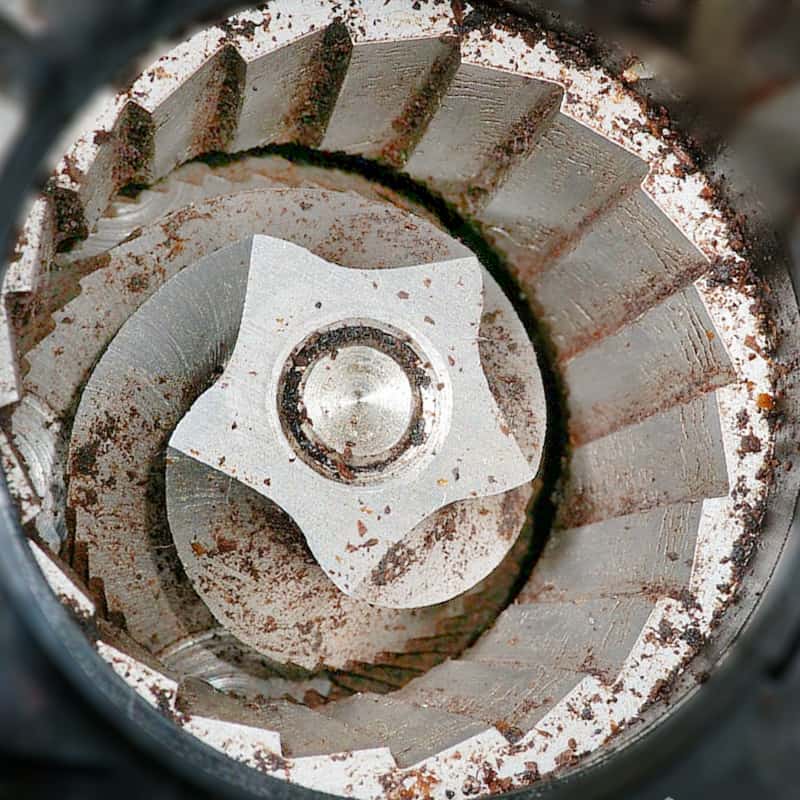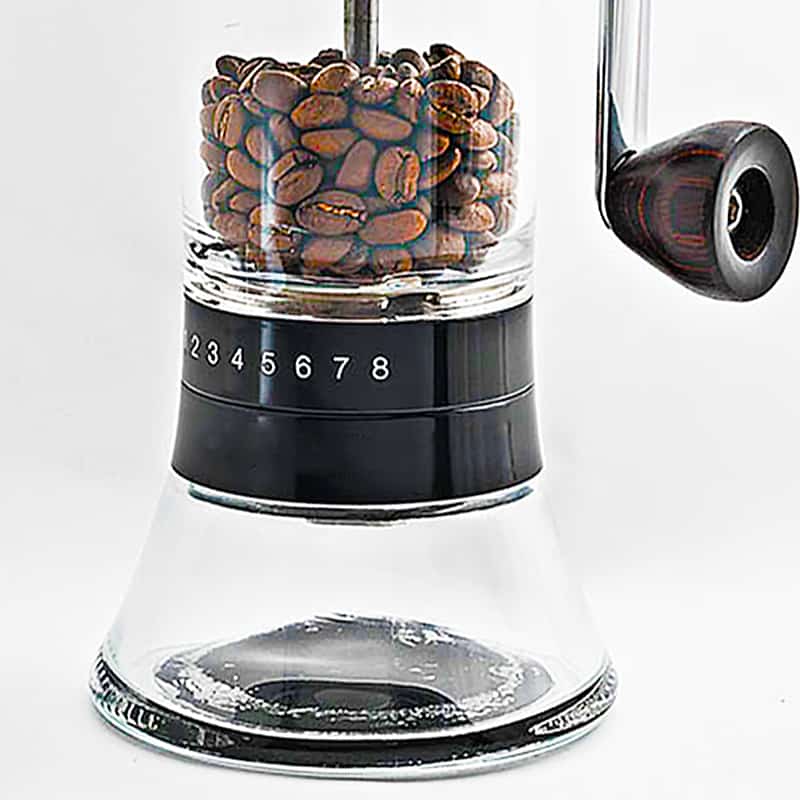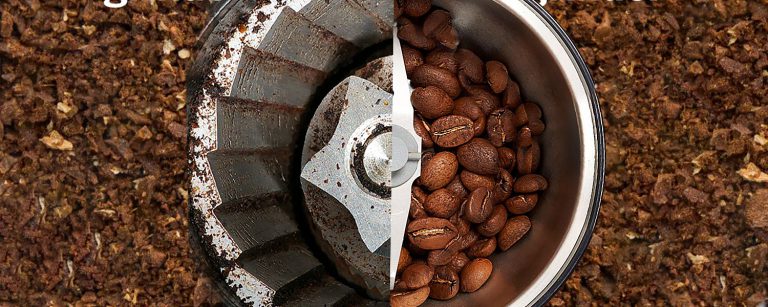Manual vs Electric Coffee Grinder Comparison – Who should use which?
What’s the best way to grind those beans? Should you go for a manual grinder that requires you to put in some elbow grease or an electric one that you plug in and press a button?
The answer is more complex than it seems.
In this article, I’ll compare the pros and cons of the different types of coffee grinders, so you can decide which is right for you.
Manual Coffee Grinders

A manual coffee grinder is a straightforward hand-powered machine composed of the following:
- a tiny hopper for storing beans,
- a set of burrs for grinding the coffee beans,
- a collection chamber beneath for collecting the ground coffee,
- a single rod that connects a handle and turns the burrs.
But what are those burrs I keep talking about, and how does it grind coffee?
It’s pretty simple. Inside the grinder are two metal plates with sharp teeth called “burrs.” When you turn the handle on the grinder, those two burrs start spinning around against each other, and they crush the coffee beans into tiny little pieces, eventually falling into the collection chamber.

You can adjust the grind size by changing how far apart those two burrs are from each other – the closer they are together, the finer the grind will be.
And most important, burr grinders produce uniform-sized grounds, which is exactly what you need for delicious coffee.
Using a manual hand grinder is very simple, and the process is the same no matter which brand and model you choose:
- Add your desired amount of whole coffee beans to the hopper at the top of the grinder.
- Select your grind size depending on how fine or coarse you want your grounds.
- Once you’ve selected your setting, hold the grinder firmly in one hand and use the other hand to turn the crank handle attached to the rod in a clockwise motion.
- Keep cranking until all of your beans have been ground to consistency (this may take some arm muscle!).
- Finally, open up the collection chamber at the bottom of the grinder and pour out your fresh, perfectly ground coffee into a waiting filter or storage container.
Pros and cons of manual coffee grinders
Manual coffee grinders are great for many reasons, but they do have some drawbacks!

Pros
Cons
The simple design makes cleaning manual grinders quick and easy – a definite pro! They’re also typically more affordable than electric grinders. Compared to automatic grinders that use electricity and generally come with plastic casings, manual grinders are also more eco-friendly.
However, they do require some elbow grease to operate (literally!), so if you’re looking to grind large quantities of coffee or want super fine grounds, an electric model may be better suited to your needs.
To help you choose, read my list of the best manual burr grinders in 2025 or check out my reviews of these grinders:
Electric Coffee Grinders
Now, let’s talk about electric coffee grinders. There are 2 types:
Burr grinders, that crush coffee beans burrs rotating against each other. These may be flat burrs (rare) or conical burrs (more common).

Blade grinders, which use a metal blade to cut the beans rather than grinding them.

Burr grinders are the industry standard since they produce consistent results every time. Blade grinders produce inconsistent grinds, so I will not discuss them in this article. Stay away from them, please.
Now, as I mentioned, electric conical burr grinders work just like manual ones do, by crushing the beans between two rotating metal plates called burrs.
You can adjust the distance between the two burrs to alter the grind size. When the beans are crushed, they fall into a chamber below where they can be collected and brewed.

Here’s how you would use an electric burr coffee grinder to grind a batch of coffee:
- Fill the bean hopper with whole coffee beans. Make sure not to overfill it so that there is room for the beans to move around while grinding.
- Select your desired grind size using the settings on your machine – most have a range of options from extra-coarse to fine.
- If your device has one, insert a grounds bin beneath the outlet before turning on the power switch.
- Begin grinding. Some electric grinders grind for a preset time, others until you turn it off, and some even weigh the amount of coffee it grinds.
- Once grinding is finished, remove any remaining grounds from inside burrs before turning off and unplugging the machine.
Pros and cons of electric coffee grinders
Electric burr grinders have some compelling pros, but also some cons.

Pros
Cons
Differences Between a Manual vs. Electric Burr Grinder
Now that you know how each type of coffee grinder works, let’s compare them from a practical standpoint.
Grind consistency
Electric coffee grinders are known for their consistent grind size. This means that you can always expect uniform grounds each time you use one.
Manual grinders are great, but they may not be able to provide this same level of consistency because it relies on the user’s arm power and control. Also, as you grab the grinder and crank away, you will be jiggling the beans in the hopper, which does not make a 100% consistent grind possible.
But with that said, the inconsistencies of a quality manual grinder are mild and will not noticeably alter the taste of your cup.
Grind settings
The number of grind settings varies from model to model, so this is something you can only compare knowing the exact attributes of a grinder.
Grind settings on a manual coffee grinder:

And on an electric grinder:

Both types of grinders work well for brewing methods that use coarse grinds.
When you get to fine grinds, things start looking a bit different. Dialing in an espresso means making small, incremental changes to your grind size to create a perfect extraction. Only the higher-quality models have enough grind settings to accomplish this task. For example, the 1zpresso J-max settings move the burrs by 8 microns per click. A micron is 0.001 millimeters, so this is the level of precision quality grinders will have.
Dosage measurements
Manual grinders are not for making large batches of coffee grounds. They are best for small doses, like those needed for a single cup or two. Their hopper is too small, and it would take too much time and effort to grind more. Especially fine grinds.
On the other hand, electric grinders can make much larger batches of coffee grounds in a shorter amount of time. Their hoopers are enormous, so there are no constraints on how much coffee you can grind with them. So if you’re using an 8-cup coffee machine at home, go with an electric grinder…
Size and portability
Manual grinders are much smaller than electric grinders, which means they use up less counter space and can even be taken along on trips.

Electric grinders are large machines that won’t fit into every kitchen, and they require electricity which means you don’t want to take one camping in the woods 🙂
Repairs and maintenance
If your grinder breaks down, you’ll have to decide whether to fix it or get a new one.
Cheaper manual grinders are usually not worth fixing. They are mechanical and won’t wear down for several years, at which point you will get a new one.
Electric grinders are a different story, and getting them fixed can be a hassle and quite expensive.
I should also mention that ceramic burr grinders are more brittle than stainless steel burrs, I prefer the later.
Messiness
Manual grinders are not messy at all. Your beans go into the hopper, you crank, and the grinds exit into the collection chamber. No mess… unless you spill your grinds like I did yesterday trying to pour them into my Aeropress.

Afterward, you can wipe the chamber and the bottom of the grinder with a dry paper towel, and do a thorough cleaning once every month.
Electric grinders are a mixed bag. The ones with a dedicated grind chamber are neater, but the models grinding directly into a portafilter can get messy. The grinder spits out the grinds without mercy, so you have to make sure something is there.
Electric grinders are faster, but this also means they can produce more static, which inevitably makes things messier.
Price
Prices vary significantly with brand and quality for both manual and electric coffee grinders.
Manual coffee grinders cost between $20 to $300, but you can get great ones for $150.
Electric grinders begin at around $50, and go into the thousands. A good one for home use will be about $200. For example, this Oxo grinder is surprisingly cheap but still produces good grinds.
As you can expect, the cheapest options will not be good in terms of consistency and longevity. This is a long-term investment, so I suggest you spend a little extra.
Which type should you choose?
Now that we’ve looked at the pros and cons of each type, you may be wondering which is suitable for you.


Here are some things to consider when making your decision:
- How much money do you want to spend? If price is a major consideration, then manual grinders are the way to go. You can get a great one for less than $150 – or even less if you’re willing to sacrifice quality. Electric coffee grinders start around $50 but can cost hundreds or even thousands of dollars depending on their features and build quality.
- Do you plan on grinding large quantities at once or just small doses? Manual coffee grinders work best for small amounts (enough for 1-2 cups). In contrast, electric models are better suited towards larger batches since they can hold more beans in their hoppers and generally operate faster overall.
- If space is an issue in your kitchen, keep in mind that manual coffee grinders are much smaller than electrically powered ones, so they’ll take up less countertop real estate.
If you want to save money and have a little arm muscle to spare, go for a manual grinder. If you’re looking for consistency, speed, and have counter space, then an electric model is the way to go.
Is Buying an Expensive Coffee Grinder Worth it?
It depends on how much you value fresh coffee.
If you’re the kind of person who is happy with any old cup of joe, then spending a lot of money on a high-end manual or electric grinder probably isn’t going to be worth it for you. A lower-priced grinder will still yield far superior results than pre-ground coffee.
But if you’re passionate about your coffee, want to experiment with different grind settings and recipes, and want to ensure that every cup is as perfect as possible, then paying more for a quality grinder is well worth it.
Just promise me one thing: don’t get an electric BLADE grinder 😬








Insightful article, Tom. I’d take it a step further and say that investing in a high-quality manual grinder can yield results close to an electric grinder, especially for those who enjoy a hands-on approach and don’t need to grind large batches.
Interesting read, but I’m left wondering about the lifespan of manual vs electric grinders. You mentioned repairs and maintenance, but could you specify which one typically lasts longer with proper care? I’m all in for long-term investments.
The manual definitely has a longer lifespan, so that’s the best route for durabiloity. But if you’re mainly into espresso like me, I recommend you get an electric one.
Does anyone have recommendations for a manual grinder that’s easy to adjust and doesn’t require a lot of strength? I love the idea of grinding my own beans but have limited counter space and can’t handle anything too physically demanding.
If you grind espresso, all manual grinders will be hard to turn. The coarser you get, the easier it is, so it depends on the type of coffee you drink. I recommend the ones in this article, most have double bearings which makes things quicker: https://bigcupofcoffee.com/best-manual-coffee-grinders/
Just got myself an electric burr grinder after reading this, and man, what a difference. I never realized how inconsistent my old blade grinder was until now. Anyone sitting on the fence like I was, trust me, the upgrade is worth it.
Tom, I’m intrigued by the point on aroma retention you mentioned. I’m traveling often and thinking of switching to a manual grinder. Could you elaborate on how significant the aroma loss is for electric versus manual grinders?
I don’t believe there is much difference if both appliances are quality ones.
I’m extremely grateful for this in-depth comparison, Tom. Your article perfectly resolved my dilemma of choosing between manual and electric grinders. As someone who’s about to venture into the world of coffee-making, understanding the pros and cons of each type has been invaluable.
Having used both types of grinders, I can attest to the accuracy of this comparison. However, I’d like to add that manual grinders can be somewhat therapeutic to use. There’s something about manually grinding beans that adds to the ritual of making a cup of coffee.